« How to deal with sharks | Main | Sharks, finally »
August 18, 2009
The Liveaboard experience
I finally got to experience a liveaboard! What does “liveaboard†mean? It means instead of staying in a hotel during a dive trip, you stay right on the boat. You travel to your destination, board the dive boat, and then live on it for the entire dive trip. Many seasoned scuba divers swear this is the best way to dive, and you get in more diving than any other way.
So we booked a trip with Explorer Ventures for seven days aboard their Turks and Caicos Explorer II. To be honest, I wasn’t quite sure what to expect. I have never been on a cruise, I’ve never owned a boat, and I’ve hardly ever been on a boat larger than a dive boat. I had absolutely no idea what to expect. What would it be like? Would I get seasick? But it all sounded interesting and so we decided on the trip. The Turks and Caicos Explorer II would be our home for a week.
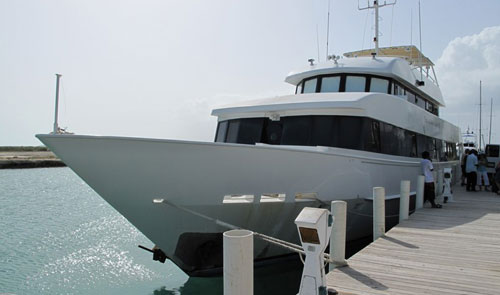
Getting there is never a lot of fun. We got up at 3AM to catch a 6AM American flight and finally arrived after a long three-leg ordeal when it was already dark. The airport on Providenciales, the most touristy of the Turks and Caicos islands, is small and homey. Immigration was quick and hassle-free, and our bags arrived promptly. We had to fill out three instead of the usual two forms, the additional being a swine flu questionnaire. Fortunately, neither of us felt sick or had had any recent contact with pigs.
Outside the airport, things were quite well organized. A uniformed transportation guy asked where we wanted to go and led us to the proper line. Another one took our luggage and made smalltalk. How was your flight? First time on the island? And so on. Though there were quite a few people, it took less than five minutes for us to get on a standard size van with one other party. The lady driver of a beat-up van was courteous enough and the ride from the airport to the Turtle Cove Inn where we would stay for the first night was less than ten minutes. The fare was a hefty US$26. I gave the cabbie lady US$30, but she glared at me and clearly wanted more. I handed over another five.
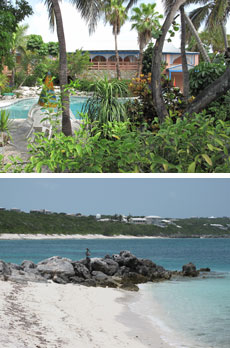 The hotel looked wonderfully tropical, but the office was already closed. Amazingly, there was a sheet of paper stuck on the door, all neatly printed and addressed to us, long name spelled correctly and all, directing us to pick up our materials at the bar and complete the check-in in the morning. The bartender apparently expected us. It was about 8:45Pm and the bar wasn’t crowded, but food was still available. After dinner we walked around the marina and marveled at the awesome yachts moored there. Many had big-screen TVs with people watching.. what? Satellite TV? The water in the marina was clean and absolutely clear. The underwater spotlights on the yachts lit up the water to the bottom and you could see fish. I don’t think I’ve ever seen a marina with such clear water.
The hotel looked wonderfully tropical, but the office was already closed. Amazingly, there was a sheet of paper stuck on the door, all neatly printed and addressed to us, long name spelled correctly and all, directing us to pick up our materials at the bar and complete the check-in in the morning. The bartender apparently expected us. It was about 8:45Pm and the bar wasn’t crowded, but food was still available. After dinner we walked around the marina and marveled at the awesome yachts moored there. Many had big-screen TVs with people watching.. what? Satellite TV? The water in the marina was clean and absolutely clear. The underwater spotlights on the yachts lit up the water to the bottom and you could see fish. I don’t think I’ve ever seen a marina with such clear water.
The next day we had some time to kill and walked down to the beach, which was marvelous, with clean, white sand and the clearest bluest water I’ve seen on any beach. The sand had little pieces of red coral in it and all the rock was also old coral. The water was perhaps 86 degrees and felt wonderful. Back at the Turtle Cove Inn, we were picked up by a van from Explorer Ventures. We picked up one final guest, driving through some very impressively luxurious developments and then headed for the Caicos Marina that turned out to be a much more utilitarian and industrial affair than the snazzy Turtle Cove Marina where we had stayed (and where Explorer Ventures’ competition, the Aggressor, anchors).
 The 140-foot Turks & Caicos Explorer II, however, is a larger boat than the Aggressor by some 30 feet and an impressive craft indeed. After unloading and taking off our shoes and socks and putting them in a box, we boarded the vessel and met the staff. Nissa, a young divemaster from Canada showed us our room, stateroom #7 on the main floor, right opposite the kitchen/mess. The room was small, of course, but big enough for two double beds combined into making a large bed. The bathroom with shower was small but adequate. With all of our electronic gear, I had been concerned about power outlets. No problem there as I found a total of four outlets.
The 140-foot Turks & Caicos Explorer II, however, is a larger boat than the Aggressor by some 30 feet and an impressive craft indeed. After unloading and taking off our shoes and socks and putting them in a box, we boarded the vessel and met the staff. Nissa, a young divemaster from Canada showed us our room, stateroom #7 on the main floor, right opposite the kitchen/mess. The room was small, of course, but big enough for two double beds combined into making a large bed. The bathroom with shower was small but adequate. With all of our electronic gear, I had been concerned about power outlets. No problem there as I found a total of four outlets.
The next couple of hours we set up our dive gear, got weights, put cameras onto the camera table at the rear of the boat, put away our clothes, arranged stuff, and so on. Then it was time for dinner and we got our first taste of chef Stan’s exquisite cooking. Eating on the Turks and Caicos Explorer is buffet style, three tables with six chairs each. The dining room/salon was much larger than I expected and even had a 37-inch flatscreen TV.
After dinner, Captain Ken introduced himself and the crew. There was Sandie, the purser; Doug, the engineer and Sandie’s husband; Stan, the chef, a local from Salt Cay; and then dive masters Nissa, Joe and Dave. Captain Ken himself is a retired oil field guy who’s now living in the Florida Keys, acting as a relief captain for a number of boats. He explained the law of the land, being both humorous and concise.
We learned that the boat doesn’t have a keel but a considerable draw due to its size, so getting in and out of marinas requires careful timing with the tides. It also means that the boat swings while anchored, left to right, so hanging onto the 15-foot stop bar when you come up can make for a wild ride. He also explained that the boat’s water is from onboard reverse osmosis systems, meaning it is completely safe to drink. And that the cooling system, with individual controls for each room, uses an air washing method and not a conventional A/C compressor/condensor, so it wasn’t going to get icy-cold. As it turned out, temperature was never an issue. Speaking with the captain I learned that the boat has a 5,000 gallon tank for diesel fuel. A week-long trip like ours burns about 1,000 gallons. The boat has a septic tank processing plant that should reduce everything to just clear water. The boat can be steered from the top deck, from a remote station on the forward side of the middle upper deck, and, of course, from the bridge.
Later, we socialized and got to know each other. I took advantage of the marina’s WiFi to catch up on email and such. Others talked or watched a movie. Three additional guests joined, meaning there were a dozen guests and seven staff. The T&C Explorer II can handle 20 guests, so we had plenty of room to stretch out.
We went to bed at 11:00PM, with the boat now moving from the marina towards its first destination off Providenciales’ Northwest Point. There was a bit of side-to-side movement, and the vibration from the big diesel engines was quite noticeable. It felt a bit like in an airplane at night, except for the extra light side motion. It took me a while to fall asleep. The bed was amazingly comfortable, and cabin temperature was fine. At some point the ship was pitching a bit more and I felt that in my sleep, but not enough to wake up.
I woke up Sunday morning at 6:28AM, two minutes before the alarm went off. The sun had just come up and was starting to burn through the haze, and the moon was still up. By 7AM we were having breakfast. Stan cooked ham and eggs to order, and there was also toast, English muffins, yoghurt and cereal.
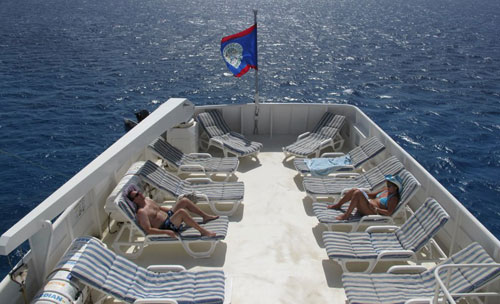
Dive master Dave, a good, humorous presenter, explained the overall dive rules and law of the land (or boat as it were). Maximum depth is 130 feet on air, 110 feet on nitrox. Maximum dive time 70 minutes, and come up with at least 500 psi left. Everyone must have a buddy unless they are solo diver certified (which no one was). The boat has two ladders and also two weighted lines for 15-foot safety stops.
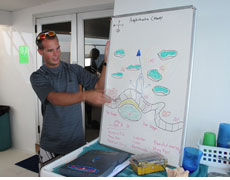 Then it was off to the first dive briefing. The crew draws a dive site map onto a whiteboard and uses that as a visual. One of the three dive masters comes along on each dive. Divers can join the dive master, or they are free to go by themselves.
Then it was off to the first dive briefing. The crew draws a dive site map onto a whiteboard and uses that as a visual. One of the three dive masters comes along on each dive. Divers can join the dive master, or they are free to go by themselves.
The first dive site was Eel’s Garden on the northeast side of Providenciales. The reef there was 40-45 feet deep, and there was a wall going down to perhaps 120 feet. Right on the first dive we saw several lionfish. They are beautiful but an invasive species and apparently a real menace as they propagate very quickly and have no natural predators. As a result, they take over and decimate the native species. They just kind of hang around in crevices and don’t seem to swim around very much. They are clearly related to scorpion fish, though they look much nicer with their colorful feather-like plumes. I can see why people shy away from killing them. The water temperature was a pleasant 84 degrees Fahrenheit or so, and my 3mil suit was plenty enough. The 80 cubic-foot aluminum tanks we got (each marked with our name) should generally last for an hour or so, depending on depth and individual consumption. I hit 101 feet on my first dive.
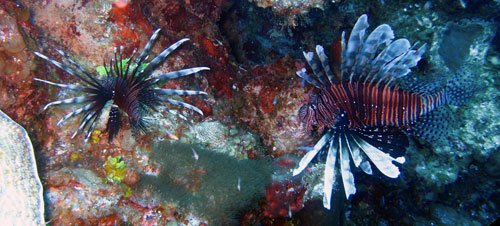
The boat did indeed swing from left to right and back, appearing and then disappearing from view. Going up required listening to the boat’s motor and timing your ascent. As we surfaced, a crew member helped with cameras and fins, and then they recorded our maximum depth, dive time, and remaining tank pressure. And a batch of delicious hot brownies was waiting, too. Yum.
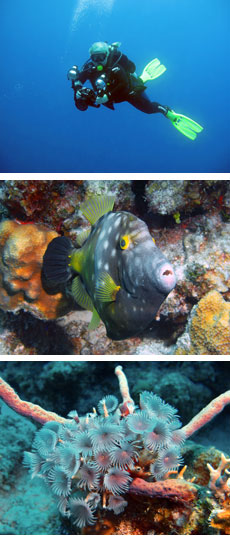 The second dive was to the same location, but this time we turned left at the wall. With the exception of the lionfish that I had not seem before, this first divesite was a little short on the usual sponges and gorgonians and seafans and all the other cool and healthy stuff we were used to seeing in the Caribbean. Like in most places there was some coral bleaching, and it was clear that some areas were still recovering from hurricanes that had hit the area a couple of years prior.
The second dive was to the same location, but this time we turned left at the wall. With the exception of the lionfish that I had not seem before, this first divesite was a little short on the usual sponges and gorgonians and seafans and all the other cool and healthy stuff we were used to seeing in the Caribbean. Like in most places there was some coral bleaching, and it was clear that some areas were still recovering from hurricanes that had hit the area a couple of years prior.
For lunch, chef Stan cooked up some delicious curry soup and served cold cuts for sandwiches. There was hardly enough time to upload pictures from our Olympus and Canon underwater cameras and replace batteries before it was time to dive again. The captain had moved the boat close to the location of the “Thunderdome,†a leftover of a French adventure TV show named “The Treasure of Pago Pago†that ran in 1993/94. The dome had been ripped off its foundation and was damaged during a hurricane and the whole thing now looks very different from the pictures in dive site books. Awesome dive though, and I saw my first ever shark.
After four one-hour-plus dives, dinner couldn’t come too soon and this time chef Stan came up with awesome steaks and baked potatoes, vegetables and salad, all topped off with berry pie and ice cream. We ate with captain Ken who told us a bit of the history of Caribbean liveaboards. Apparently, they all got started when so called “crew boats†that ferried workers to oil platforms in the Gulf went out of service during the oil crises in the early 1980s. Many were repurposed, and some became liveaboards. One problem was that crew boats generally were a bit too small, just under 100 feet and 100 tons, and so many were added on to. I learned that our boat, the Turks & Caicos Explorer, has additions to the front and back, and almost the whole super structure was added as well. These additions are one of the reasons why the boat swings so much when moored. The propellers are not all the way in the back either; they are where the boat originally ended.
What happens is that the boat swings back and forth within maybe a 60 degree angle. Others have written about this phenomenon, but I couldn’t quite picture it until I experienced it myself. As you get back to the starting point, you may see the boat, but it may move away and out of sight before you can catch one of the lines. The crew recommended to just wait until it comes back, as it always will. You can also grab the line and go along for the ride, which means you have to hang on to your hat if you had one (I did have a do-rag that almost came off, I was dragged through the water so quickly).
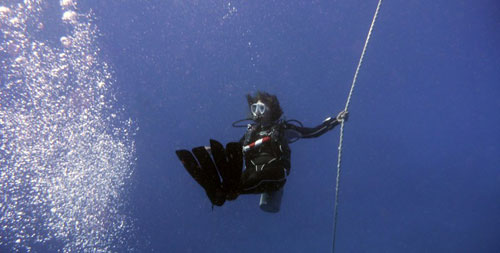
After dinner it was time for a night dive and we went back to the Thunderdome. I had expected to be nervous descending into the black ocean, but I wasn’t. We all had green lights attached to our tanks (the boat sold them at a small cost) so we could easily be located, and we all had two divelights. The lights were clearly visible and so it was easy to locate one another.  Diving around the dome in the dark was fun and the divelight spectacularly illuminated the structures. We again saw the nurse shark we had seen in the afternoon, now swimming with a big turtle. A moray eel was hunting in the beams of our lights. A lot of big jacks swam around us. When it was time to return to the boat I wasn’t sure what direction to go. Carol wrote on my slate “Look for the boat’s strobe!†We found that and swam toward it, with the strobe appearing and disappearing with the boat’s swinging. I eventually managed to grab the weighted line.
Diving around the dome in the dark was fun and the divelight spectacularly illuminated the structures. We again saw the nurse shark we had seen in the afternoon, now swimming with a big turtle. A moray eel was hunting in the beams of our lights. A lot of big jacks swam around us. When it was time to return to the boat I wasn’t sure what direction to go. Carol wrote on my slate “Look for the boat’s strobe!†We found that and swam toward it, with the strobe appearing and disappearing with the boat’s swinging. I eventually managed to grab the weighted line.
So that was five long dives this first day, and, if you were up to it, five dives every day. That’s one of the great things about being on a liveaboard: you can dive to your heart’s content without ever having to heft around your dive gear, hang it up to dry, or even worry about your tanks. That’s all taken care of, always.
The T&C Explorer II’s crew was delightful. Dave, a Brit from Liverpool, is ever friendly, witty and helpful, and does excellent dive briefings and presentations. Of his two colleagues, Joe is very friendly and personable, too, and a total expert at locating small critters. He is very pleasant and patients. Purser Sandy is friendly, personable, helpful and very pleasant, too. They all act like friends going out of their way to be good hosts rather than staff. Chef Stan doesn’t talk much, but the man can cook.
At night we uploaded pictures and then went up onto the two upper decks to watch the stars. That was an amazing experience. Even with the boat lights still on, we could see millions of stars. There were what seemed to be clouds, but it was the milky way AND numerous galaxies. Quite different from watching the sky in suburban California where city lights light up the sky and all you can see is a few stars of the major constellations.
Early the next morning, perhaps 4 o’clock or so, the boat started for West Caicos, an uninhabited island that’s southwest of Provo. It’s a rocky, flat 6-mile strip of land that is protected both inland and along its shores where it is a marine park. You can see some old structures on it, and apparently there have been renewed efforts at developing, but they fell victim to the bad economy.
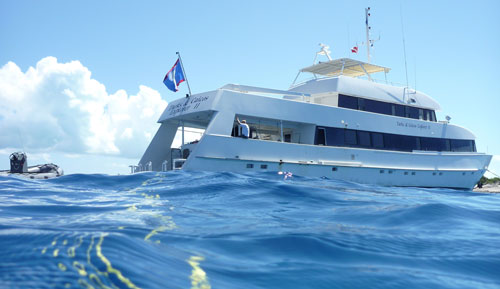
One thing that really impressed me was the spaciousness of the vessel. I had expected everything to be small and cramped. Instead, the dining room/salon was very generously sized and didn’t look like a cafeteria at all. You felt instantly feel at home here.
The beds were exceptionally comfortable. Maybe it’s because you sleep well after four or five dives, but I have hardly slept better. You get two pillows each. The crew makes up your bed while you have breakfast, and in the evening they even put a chocolate on your pillow. You get new towels every day. They differentiate between inside and outside towels. The ones outside you just take and use to dry off after diving, or after having taken a hot shower on the dive deck after a dive.
 The shower in our room was good, though I must admit I hardly ever used it. When you dive all day and shower outside after each dive, it just doesn’t seem necessary. I mean, why shampoo and blow-dry your hair when it gets wet again instantly anyway?
The shower in our room was good, though I must admit I hardly ever used it. When you dive all day and shower outside after each dive, it just doesn’t seem necessary. I mean, why shampoo and blow-dry your hair when it gets wet again instantly anyway?
Even though I brought as few clothes as possible, I still brought too much. All you really need on a liveaboard is underwear, T-shirts and bathing suits. You always walk around barefoot. You really only need to pack what you wear for travel.
Money, likewise, is not needed, at least not during the week. All food and drink is provided, and that includes beer, wine, and even hard liquor from the liquor cabinet. No one in our group abused that, so I am not sure if there are limits.
Cabin doors mostly remain unlocked. You don’t even have a key, or at least I never used one. You can lock them from inside at night or when you’re inside so that the crew does not inadvertently walk in on you.
Our airfills were always done on time, with green caps meaning you wanted nitrox, and red caps air. Nitrox was reliably at just about 32%, and air fill pressure didn’t vary by much. The lowest I saw was perhaps 2,900psi, the highest 3,150psi. There was always someone waiting to help you when you came up, the name of the diver coming up was communicated, and once you were out of the water you were asked your depth and remaining air.
My dive time was generally just about an hour, and I usually came up with 500-650psi. Finding the boat often ate up some time as the reefs/sandy bottom were generally fairly deep (45-60 feet) and the boat could be hard to see. Watching the individual dive patterns and styles was interesting. Some almost always go deep whereas others never do. Some almost always come up with less air than they should whereas others keep it on the safe side. Some are hot-dogging underwater whereas others try to move as efficiently as possible. Some are elegant, others less so.
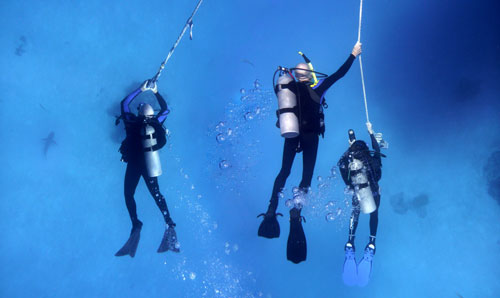
On Thursday I woke up to some pretty heavy rolling and decided I probably better take a ginger candy, just in case. The ride from West Caicos to French Key is perhaps 15 miles and takes less than three hours. The trip is along the fringe of the shallow Caicos bank, but it is open water, and so things get a bit choppy even in good weather. I eventually got up and went on the top deck, sitting in the captain’s chair letting the wind blow through my hair, and seeing nothing but water all around. A bit later French Key came into view, a small, uninhabited sandy patch that barely sticks out of the water by a few feet.
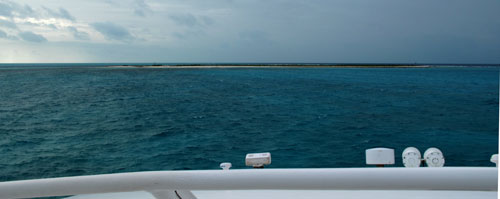
The water was rougher there, so getting in and out of the water was a bit trickier. The dive entry dock at the rear of the boat is almost level with the water, so when it gets rocky, waves just wash over it and the crew has to make sure to close the two doors to the utility room of the dive deck.
With some 20 dives under our belts, we actually skipped the second dive Thursday afternoon because the seas were pretty rough by now. One of the truly nicest dive sites I’d ever seen, and I skip an opportunity for a second dive! I suppose that’s what a total of 20 hours underwater within five days will do. Carol simply fell asleep while watching our latest dive pictures. Those who went on the dive didn’t have a great time due to very strong surge and current at the bottom, and then the heavy seas when getting back to, and onto, the boat. One diver actually missed the sinkerline and had to use his safety sausage.
As it turned out, the Thursday dive was to be my last on the Turks & Caicos Explorer II. The weather that had turned pretty rough in the afternoon got worse and no one went on the night dive, despite its reputation as the best night dive off the island.
The captain gave a farewell briefing and announced there’d be a dawn dive (5AM) Friday morning that would give you a chance to see all the sea creatures go the other way after a night’s feeding and activities. At 8:30AM there would be another regular dive, the last, at a French Cay site named “Rock & Roll.†As is, we had plenty of rock ‘n roll Thursday night while moored at the G-Sport site off French Cay. The captain had said he might move the boat behind French Cay so as to at least get a reprieve from the wave action. There wouldn’t be much to break the wind as the Cay is small, bereft of all vegetation, and only a few feet above sea level.
The rocking and rolling increased as the evening wore on and it became almost impossible to walk. Cans and bottles in the fridge banged around like crazy and the crew used duct tape to secure cabinet doors and such, and also secured the kitchen. In our room, everything that was on the table was thrown off onto the floor, despite the lip that surrounds half the table. A soda fell off and drenched the carpeting.
At 11PM the captain announced he was going to move the boat behind French Cay. The water there was only maybe 8-10 feet, and that required some precision navigation by the captain and the crew. We dropped anchor around midnight. Carol and I went up on the top deck. The waves had calmed down some but it was still quite windy. We went to sleep around 12:45. I felt the rocking motion once or twice, but soundly slept through the night.
Overall, this was a wonderful experience and I am very glad we did it. I have nothing to measure it against, so I don’t know if the little glitches are par for the course, or if the overall family-feel of the crew is normal. I don’t know if everything is supposed to be polished and gleaming or if signs or wear and tear are normal in a vessel that spends most of its time at sea.
The Lonely Planet book on Turks & Caicos said, “many experienced divers believe the Turks and Caicos islands offer the best diving in the Caribbean. They certainly offer a world-class diving experience. Excellent visibility, unspoiled reefs, spectacular vertical walls, and an abundance of marine animals both big and small attract divers from around the globe.†I can mostly agree with that, though the hurricane damage will take some more time to heal.
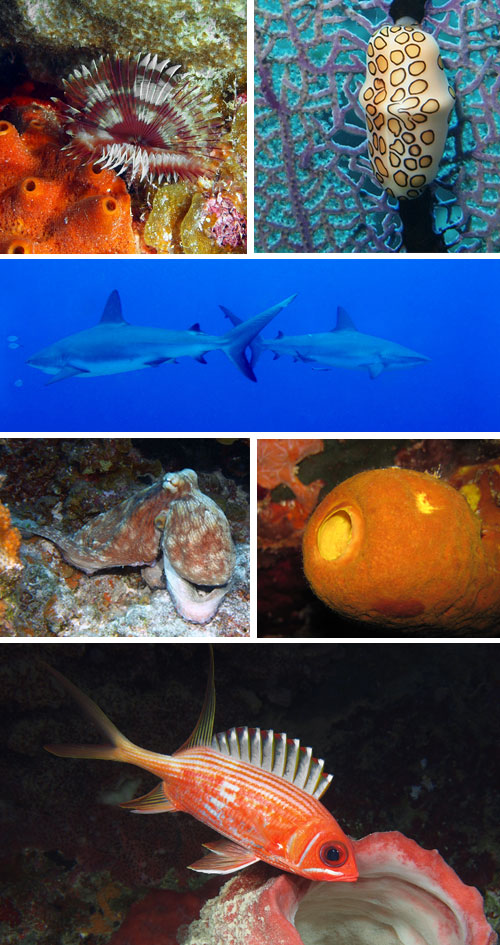
Some observations: don’t worry about bringing sunscreen and bug repellents unless you have special needs. There is a box with just about anything. I suppose guests leave theirs here. Also, there are dozens of book to read should someone get bored (which I cannot imagine). For entertainment there was the big flatscreen TV, two DVD players, and a Sony sound system. No need for shoes on the boat. You go barefoot the entire week. And though we didn’t bring a lot of clothes, we brought way too much.
The last morning I felt sort of strange. The trip had gone by much too fast. The crew was busy beginning to ready the boat for the next group of guests, and also used their computers to follow the predictions for hurricane Anna, the first of the season. The captain made arrangements in case they had to cut the trip short and seek shelter in the marina.
So that was a week on a liveaboard. It’s a wonderful experience.
Posted by conradb212 at August 18, 2009 3:35 AM








